It was quiet and peaceful overnight without a stupid nearby rooster. We got up at 7:15 and left camp at 9:00. On our way out, we paid for our campsite, 80 pula. In the Maun Rest Camp office there was a sign warning guests to be vigilant and to keep valuables out of sight at all times because of crime problems due to "illegal aliens from countries to the east." Of course, the country to the east is Zimbabwe, long on the verge of collapse as a result of the failed policies of its corrupt president, Robert Mugabe.
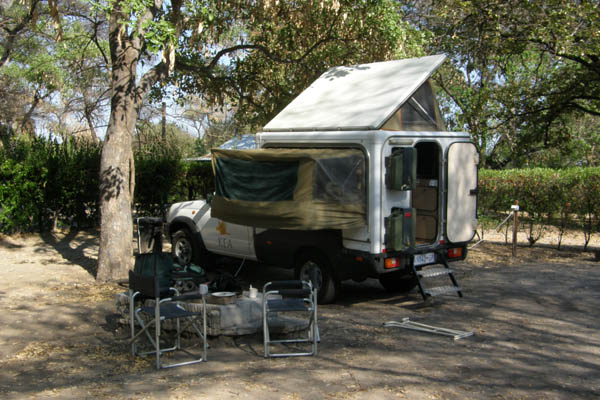
The camper all set up
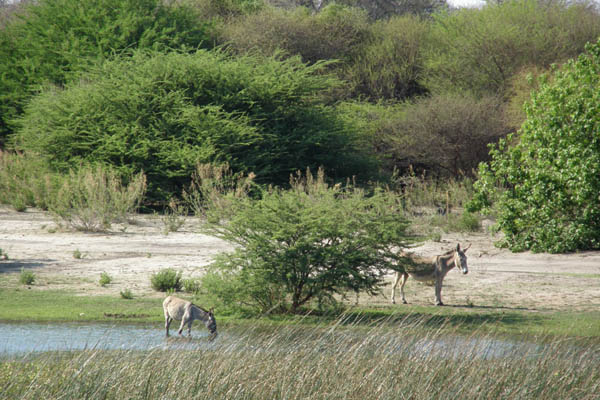
Two of Botswana's omnipresent donkeys
Prior to our trip, I had tried to organize camping permits with Botswana's Department of Wildlife and National Parks (DWNP), with no luck. I couldn't get through by fax, and by email I first got a negative response and then later no response at all. We'd also contacted a travel agent in Maun who went in person to the DWNP for us, but the campgrounds where we wanted to stay were booked, so we would have had to radically alter our plans, plus the travel agent wanted a rather large booking fee. So with no firm idea of where we'd be staying once we reached Botswana, we therefore traveled halfway across the world anyway.
So this morning, with slight trepidation, we presented ourselves at the DWNP office in Maun, a nondescript little prefab trailer behind the police station, to see what, if any, campsites we could book in the parks. It took about five minutes to reserve almost our ideal itinerary and receive our official green DWNP "Parks and Reserves Reservation Office Confirmation." It was the easiest thing we'd done in Africa thus far. We reserved two nights at Third Bridge in Moremi Game Reserve, one night at Savuti (also spelled Savute) in Chobe National Park, and one night at Ihaha, in a different part of Chobe. Our second night in Moremi we really wanted to stay at Xakanaxa, but they said it wasn't possible, and we were thrilled with what we got.
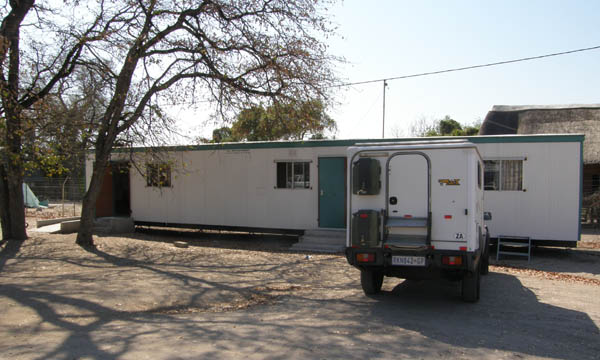
Department of Wildlife and National Parks, Maun, Botswana
While in Maun this morning, we bought even more water to take into the bush and stocked up on some rum, beer, and South African wine. Anything in bottles is a little tricky with the 4x4 driving, so I wrapped the rum and wine in our extra clothing, wedged it in as best I could, and hoped it wouldn't become shrapnel. I'd intended to get more pula this morning, but the first two ATMs we came across were out of service, and the banks had massive lines. So since they told us at the DWNP office we could pay the park fees at the gate in US dollars, we pressed on without additional cash. (Accepted currencies at the park entrance gates are pula, US dollars, British pounds, South African rand, and the euro.)
Just before leaving town, we stopped by a business with a sign out front advertising Internet, but when I went inside, they didn't actually have it. I'd wanted to send out a "we're alive" email before we went into the bush for the next few days, but it wasn't to be. At 9:45, with all our errands either accomplished or abandoned, we headed for Moremi Game Reserve.
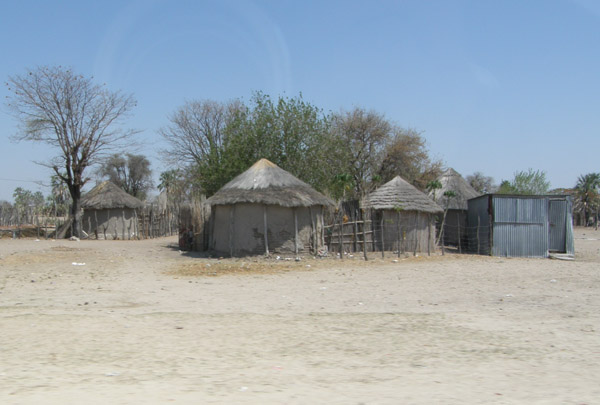
Rondoval huts, Shorobe, Botswana
The road to Moremi is paved as far as the village of Shorobe, 47km northeast of Maun, then it turns to so-called gravel, a sun-baked track more like broken-up pavement being taken over by sand. 19km past Shorobe the road enters into a veterinary control area. At the gate, the driver signs a book and enters the vehicle's registration number. Every place we went in Africa, they wanted our vehicle registration number. The guard let us past the roadblock, and we reached the first of the infamous sand tracks of Botswana. We were completely out of our element driving through sand, but in a way it was a relief to be on the soft sand after the bone-jarring thrill ride of the gravel road. Later on I'll wish for gravel again.
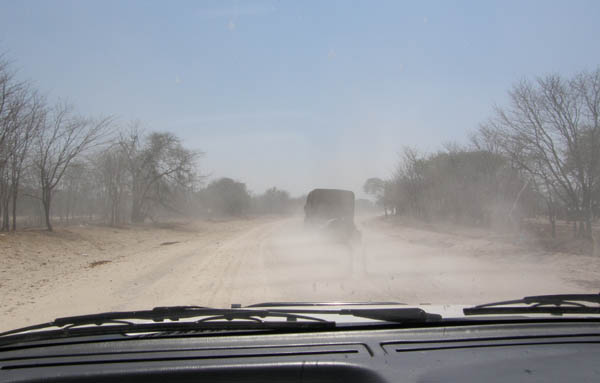
Army truck passing by on the "gravel" road
From our guidebook, "Botswana, The Bradt Safari Guide," by Chris McIntyre: "Botswana's bush tracks are maintained only by the passage of vehicles, and aren't for the novice, or the unprepared."
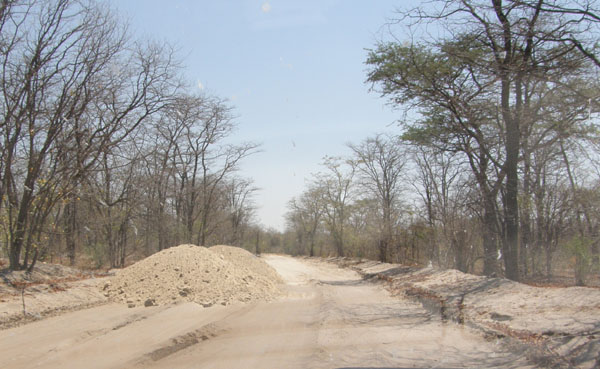
The first of the sandy tracks
Past the veterinary control fence, we started seeing signs of big game - broken brush where elephants had passed, sun-bleached bones, and the biggest poo you've ever seen. Then we saw a giraffe! Then we saw a bunch of giraffes! And we weren't even in the park yet! Tom stopped the truck while a group of giraffes crossed the road in front of us. They're pretty timid for such large animals, and they were obviously wary of us. We watched mesmerized as they passed by.
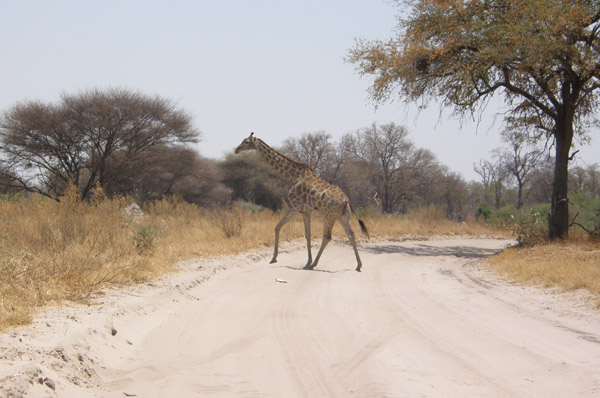
Giraffe!
From the vet control fence, it's another 29km to the South Gate entrance to Moremi Game Reserve, where we showed our paperwork and paid the fees. The game wardens had us pull to the side and wait while a bunch of Botswana Army trucks entered the park. I was pleased to see they had to show paperwork as well. We'd seen the army trucks parked outside of Shorobe, and several of them had passed us on the gravel road, kicking up a dust storm each time. Probably they were taking a shortcut through Moremi to Botswana's border with Namibia.
The national parks fee is 120 pula per non-resident per day entrance, 30 pula per person per day camping, and 50 pula per day for a foreign-registered vehicle, totaling 350 pula per day per couple, or US$64. We paid $128 cash for our two nights in Moremi and received our official "Permit to Enter National Parks and Game Reserves." The Chobe National Park fees will be paid separately.
Moremi Game Reserve protects the eastern one-third of the Okavango Delta, home to a large and diverse population of wildlife. The Okavango River begins in the highlands of Angola, flows through Namibia, and in Botswana forms the Okavango Delta before disappearing into the dry sands of the Kalahari Desert. October is dry season, a good time for game viewing because the seasonal pans are dry, so the game concentrates in areas of permanent water, and there's little vegetation in which the animals can hide. Some might think we're crazy visiting in "suicide month," when the temperatures regularly exceed 100 degrees, but we like it hot. The eastern portion of Moremi, known as the Mopane Tongue, where a peninsula of dry land extends into the delta, is the only part of the reserve accessible by vehicle, 4x4 only.
Past South Gate, we took an immediate left toward Third Bridge, then a side loop to the amazing Xini Lagoon. A herd of elephants was just finishing a drink and a dip and marched out of the area just after we arrived. It was like they'd been waiting for us. We saw an African fish eagle, various species of antelope, herds of zebras, and an abundance of warthogs. Tom and I were the only people around. It was our own private Wild Kingdom!

Xini Lagoon, Moremi Game Reserve
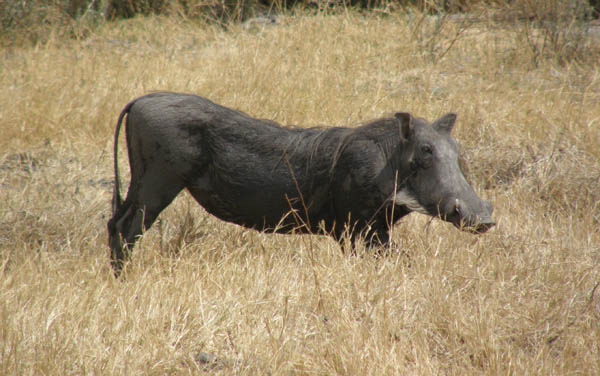
Winsome warthog
Finding the lagoon an ideal spot for a picnic, I stepped into the back of the camper to make some sandwiches, while Tom watched out for any wildlife that might try to sneak up behind us. The air was so hot and dry that the bread turned to toast as we ate, but what a view we had!
The path from South Gate to Third Bridge Campsite is only 58km, but it took us almost seven hours. The track is deep, soft sand that tossed our vehicle from side to side along the ruts. Finally, the sand got too deep, we were moving too slowly, and we got stuck bad. The truck sunk up to its axles and the tires were spinning. Tom got out and started to dig. I got out and started to dig. We gathered wood and put it under the tires for traction. We lowered the tire pressure for traction. Nothing worked. We got out the jack, and Tom was going to lift us out of there. That's when we discovered that the handle for the jack that we'd gotten from Kea did not match the jack Kea had provided, and any attempt to make it work even on firm, level ground would have taken hours. All this time, of course, we're on hyper-alert, feeling like prey, not knowing what kind of animals might come long. Luckily, besides birds, all we saw was one curious juvenile giraffe.
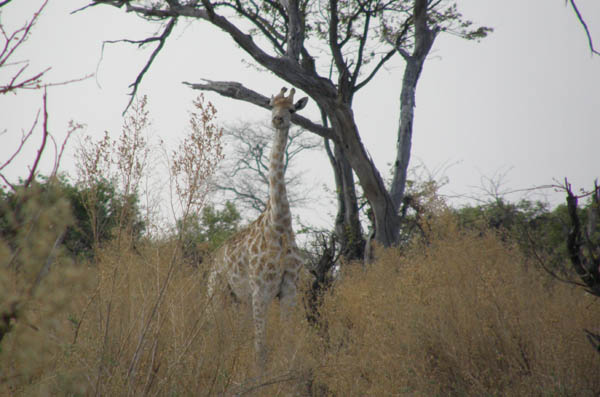
Watching us while we watch back
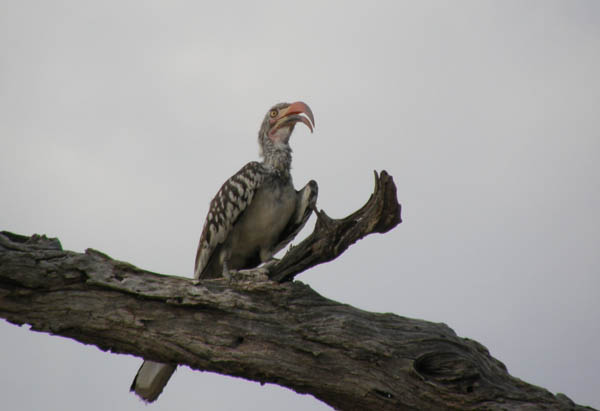
Scavenger bird, waiting for us to die
Here we were, stuck in the middle of the road on one of the main paths of the park, less than 10km from Third Bridge; we'd been here three hours, and not a single other vehicle had come along. Just before we left Knoxville, I'd communicated by email with a woman who had just returned from a trip to Botswana. She and her husband had gotten stuck in the sand in Chobe National Park near Savuti and had to spend the night, until a group of South Africans gave them a tow the next morning. I felt sure we were about to do the same. I thought what an amusing anecdote this would make for my journal later, assuming we don't get eaten in the meantime.
We did have one more hope at extracting ourselves. Driving in sand is easier when it's cool than when it's hot because the sand is firmer and more compact when it cools down. We'd wait a while longer, till just before dark, try driving out of it one more time, and then camp for the night and try again in the morning. Otherwise, we'd just have to wait for assistance. Then, when I least expected it, along came a big overlander tour truck from Bush Ways Safaris headed the opposite direction. Two of the guides and a passenger hopped out and gave us a push, and we were on our way!
It was only a couple more kilometers till we got stuck again. What the hell? Wondrously, we were barely out of the truck with our shovel when another vehicle came along, traveling the same direction we were, toward Third Bridge. It was a British couple in a bigger truck than ours who said they had plenty of experience getting stuck themselves. They gave us a tow out and said they'd follow us on in to camp in case we had any more trouble, which we did, and they pushed us out one last time. The British bloke advised Tom to drive no less than 30 to 40 kph on the sandy track, and if Tom felt the truck starting to bog down, to immediately drop it into first gear, no matter how fast we were going. I was just hoping we wouldn't meet anything, vehicle or animal, in the road. It was a WILD ride the rest of the way, but we made it to Third Bridge just at dark.
When we got to camp, we saw that our jerry-rig, piece-of-wire fix to hold the back stairs in place did not withstand the thrashing about the camper took on the last few kilometers of driving. The stairs had fallen and jerked about until a bolt shook loose, and now the stairs were barely holding on by a single nut and bolt. We used another piece of scrap electrical wire in place of the missing bolt so the stairs didn't fall off completely, and then used a lot of care entering and exiting the camper.
The Brits didn't have a camping reservation, so we offered to let them share our pitch, but it really wasn't necessary because, 1, there was no one there to check your reservation; 2, people were camped randomly all around the campground and no one seemed to care; and 3, it wasn't crowded at all, just one overlander group with a few ground tents and about a half dozen of us self-drivers. People who camp in the park without reservations don't camp without paying, though. Everyone must sign out when they leave the park, and the game wardens double-check your permit to see if you've paid the required fee for the number of days you've visited. If not, you pay upon exit.
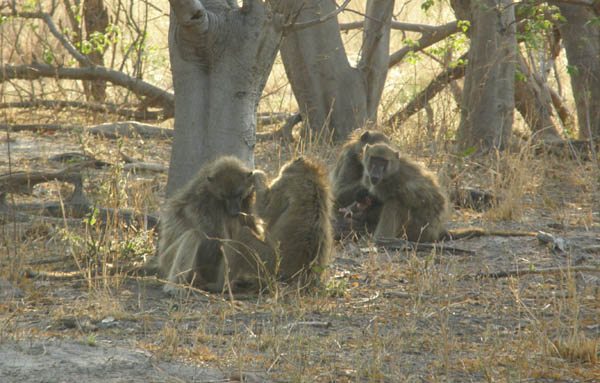
Pesky baboons at Third Bridge Campsite
We were having trouble finding our correct camping pitch in the dark, and what we thought was our site was infested by menacing-looking baboons. A bit intimidated by the events of the day at this point anyway, we opted to make camp in a clearing quite near the ablutions and reasonably close to other people. The ablutions in Moremi are pretty low on frills - no TP, no hot water, and no electricity. Too filthy from digging in the sand to wait till morning to clean up, we showered by flashlight. On a positive note, if there were spiders in there with me, I didn't know it.
The camping grounds in Moremi and Chobe are not fenced, and anything can come wandering through. Tom saw a hyena out the window while he was showering, then we saw another one later walk right past our camper while I was making dinner. Hyenas are bigger than I thought. Believe me, they're much larger when they're not on the opposite side of a fence like in a zoo.
Tonight I fried up some diced steak with the rest of the bell peppers and a can of "Hot & Spicy Chakalaka," a ready-to-serve can of spicy mixed vegetables - cabbage, tomatoes, carrots, onions, tomatoes, bell peppers, and spices. It was very good and truly hot, even to my usually flame-proof mouth. I wish I could buy Chakalaka at the Food City in Knoxville!
We stayed up till 11:30 looking at the stars and winding down from our exciting day. We could see so many stars, and even the Milky Way! Getting stuck in the sand was pretty tiring, so tomorrow we're going to give ourselves an easier day.
150 kilometers Maun to Xini Lagoon to Third Bridge.